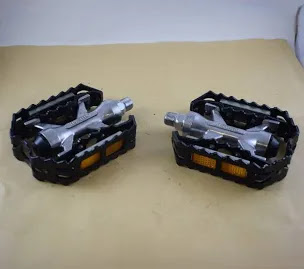In 2015, I wrote a post about Lyotard pedals. The French manufacturer was best known for its Models 460–the alloy “rattrap” model popular with cyclo-cross riders and bike tourists and commuters—and the 23, a.k.a., Berthet, a platform pedal that inspired the MKS and White Industries Urban Platform pedals. Many ‘70’s Bike Boom-era machines were equipped with other models like the 45 (an alloy quill pedal) and the 136R, which was more or less a steel version of the 460 and sometimes had built-in reflectors.
Nowhere in the brochures I could find—or in articles like the one on the Classic Lightweights website—did I find a reference to this:
I am guessing that like Lyotard’s clipless pedal, it wasn’t made for very long.
Both the BMX and clipless models, as good as they may have been, seem to have been “last gasp” efforts to keep the company, which seems to have ceased trading in the late-1980s, afloat. Lyotard’s sales of its less-expensive pedals (like the steel ones I mentioned) tanked, even as original equipment to manufacturers, when cheaper imports became available. Then the market for its higher-end pedals (and those from other companies) all but disappeared once Look and Time made easy-to-use clipless pedals available around 1985.
That year was also around the peak of BMX’s popularity—and when the cycling world was starting to realize that mountain bikes weren’t “just a fad.” While Japanese companies made many of the early BMX- and mountain-bike-specific parts, and Campagnolo even offered full gruppos for a couple of years, French bike and component manufacturers were slow to enter the mountain bike world and hardly touched BMX at all.
So, it’s hard not to wonder (for me, anyway) whether Lyotard would still be with us—and, in fact, be the presence it once was—had they started to make pedals like the ones in the photos—and clipless pedals—sooner.


